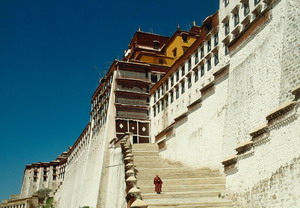
Potala Palace
Potala Palace the architectural wonder is Lhasa's cardinal landmark. It can be seen from all directions for miles around.
With its world-wide reputation, the Potala Palace stands on the Red Hill overlooking the Tibetan city of Lhasa as a major national cultural monument. This architectural wonder is Lhasa' cardinal landmark. It can be seen from all directions for miles around. Potala was set up in the seventh century AD during the reign of King Songtsen Gampo. It's located on the Red Hill, covers an area of 41 hectares.
Potala consists of the White and Red palaces with more than 1000 rooms. The white places was for secular use.
It contained living quarters, offices, the seminary and the printing house. The red Palace's function was religious. It contained gold stupas, which were the tombs of eight Dalai Lamas, the monks' assembly hall, numerous chapels and shrines, and libraries for Buddhist Scriptures.
With its world-wide reputation, the Potala stands on the Red Hill overlooking the Tibetan city of Lhasa as a major national cultural monument.
The name of the large sacred Buddhist building complex is a derivation from Samskrit Potalaka which is the mythical mountain abode of Avalokitesvara, one of the Bodhisattvas (Buddhist saints). In this connection Lhasa is popularly referred to as Second Mount Potalaka.
At an elevation of more than 3,700m, the Potala occupies an area of more than 360,000m. Its 13-story main portion rises 117m. The whole complex, consisting of halls, stupa-tomb halls (where the relics of the supreme lamas are preserved), shrines, prayer rooms, monks' dormitories and courtyards, is recognized as the world's highest and largest castle palace.
Built against the terraced slope of the hill, the structures combine to from a huge sky-scraping mass, reminscent of the divine realm above the mortal world. The granite walls elaborately decorated with soft white thatch, the golden roofs decorated with big gilded bottles, the splendid curtains and banners, join to form a unique structural wonder bearing the striking colors red, white and yellow characteristic of Tibetan architectural art, making the Potala an eminent example of a constructive technology traditionally Tibetan and Chinese.
As the winter residence of the successive Dalai Lamas, the Potala formerly served as the center of local Tebetan theocratic rule, hosting the major religious and political ceremonies since the reign of Dalai Lama V (1917-1682), at the same time housing the relics of those spiritual leaders.
The earliest project for the Potala started in A. D. 631 under Tibetan King Srang00brtsan-sgam-po (617?-650), which included 999 royal rooms plus a meditation chamber. That building was eventually destroyed by thunderbolts and wars.
Dalai Lama V, in his effort to consolidate his theocracy, entrusted in 1645 Bsod-glan-rab-den, his minister, with the rebuilding of the portion known as the White Palace of the Potala and also the enclosures, towers and turrets. When the project was completed, the patriarch moved his government to the new building from Bras-spungs Monastery.
Later in 1690 Prime Minister Bsam-rgya-mtsho enlarged the Red Palace as a part of his project to build Dalai Lama V's stupa-tomb. The extension was eompleted in 1693, which was to be followed by new projects sponsored by later Dalai Lamas, including 5 golden roofs and a number of accessory structures.
The Potala assumed its present form and scale in 1936 when Dalai Lama XIII's (1870-1933) stupa-tomb was completed.
The main portion of the Potala contains the White Palace and the Red Palace.
The 7-storey White Palace, Dalai Lamas' winter residence, also housed the former local Tibetan government. There the most spacious hall, the eastern Audience Hall (Sishe Phuntsok) occupies a central area of 717m on the 4th floor.
 Tours inclusive of visiting the Potala Palace, Lhasa Tours inclusive of visiting the Potala Palace, Lhasa
|